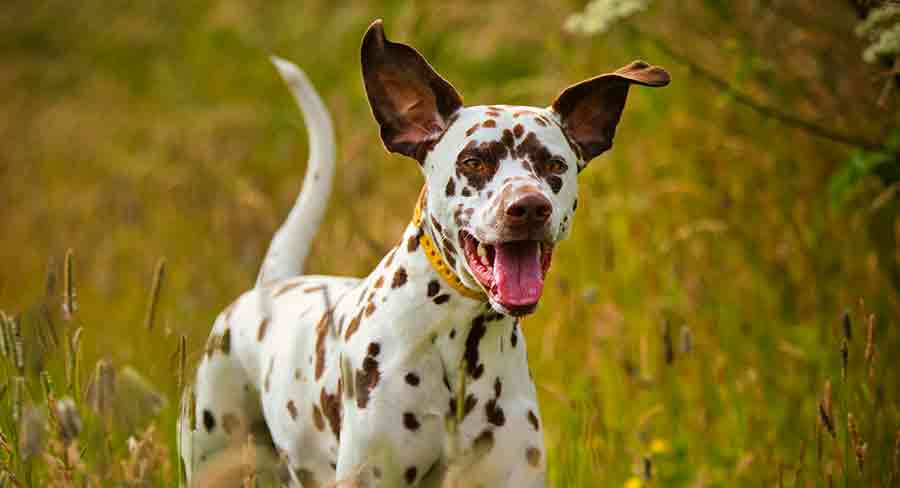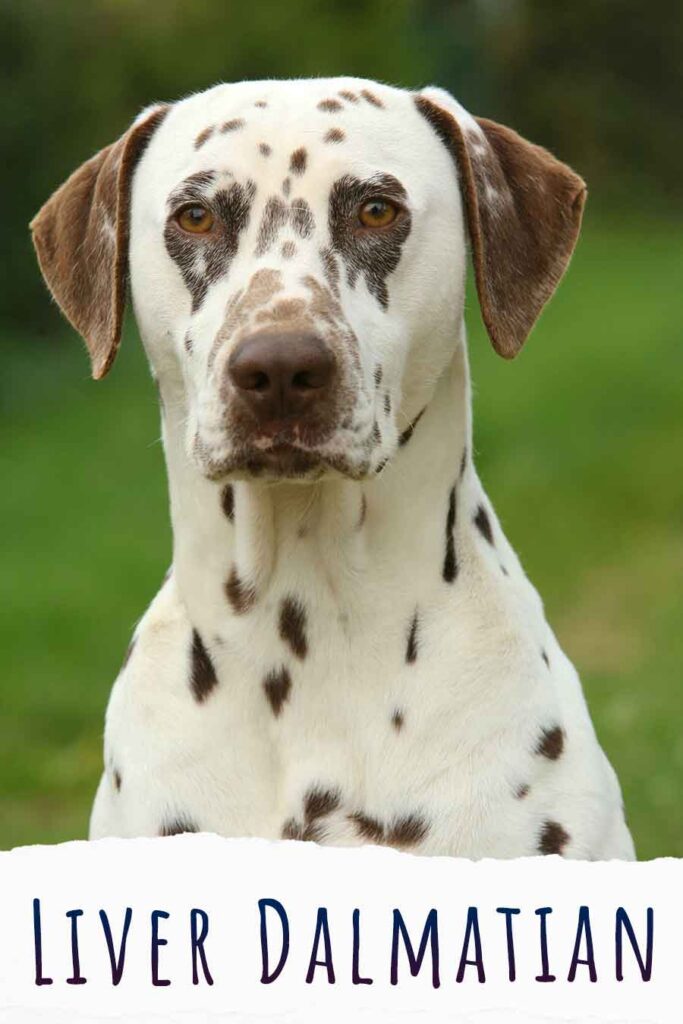
This complete guide to the liver Dalmatian has everything you need to know about brown spotted Dalmatian dogs, and how they compare to their better known black spotted cousins.
Liver spotted Dalmatians have spots of chocolate brown. They are less common than the black Dalmatian, but equally clever, energetic, and companionable. Let’s find out if these Dals with a difference might be the right dog for you!
What is a Liver Dalmatian?
A liver Dalmatian is a Dalmatian with brown spots instead of the better-known black ones. You might also hear them described as a liver and white Dalmatian, or a brown Dalmatian. Liver is one of the two standard purebred Dalmatian colors – the other, of course, being black! Besides chocolate brown spots, a liver spotted Dalmatian also has:
- Brown pigmented nose leather, instead of black.
- Blue or brown eyes which are usually a few shades lighter than a black Dalmatian’s.
- And white or brown toenails, instead of white or black.

Just like their black-spotted cousins, liver Dalmatians are born white, and their spots start to emerge from about 10 days old onwards. The exact shade of brown in a liver Dalmatian’s spots might change as they grow up, or grow old. It might also get subtly darker or lighter with the seasons.
Some liver colored Dalmatians also have brown patches, which are bigger than spots and visible from birth. These are most likely to appear on their ears or eyes (like the handsome boy in our photos), shoulder, or at the base of their tail.
Black Dalmatians whose spots have turned bronze with age or in the sun are not the same as liver Dalmatians. In fact, Dals can only have black or brown spots – not both! And the reason for that lies in their genes.
Liver Dalmatian Genetics
The majestic liver spotted Dalmatian coat is the result of a completely unique combination of genes. All Dalmatian coats start with an instruction for a color. Usually black, but sometimes brown, or even lemon! Brown spots are actually a modified type of black spot – liver Dalmatians carry two copies of a gene called the b gene, which changes the instruction to make black pigment into an instruction to make brown pigment. The instruction is only carried out when Dalmatians have two copies of the b gene, one from each parent. If they only receive one, they carry it silently and have black spots. This is one of the reasons liver Dalmatians are less common than black Dalmatians.
On top of the instruction for a color, all Dalmatians also express the extreme white spotting gene. This gene overlays huge white patches on top of the color underneath, and it’s why Dals look like their base color is white. If the white patches have any gaps between them, those gaps show up as the patches of color we talked about earlier.
Finally, Dalmatians carry the ticking gene. This has the eye-catching effect of poking holes through the white patches left by the extreme white spotting gene, so the color underneath shows through!
Liver Dalmatian Temperament
Dalmatians don’t just look completely unique, they have a unique history which gives them a distinctive temperament too. Dalmatians are the only AKC-recognized dogs which used to be employed as coach dogs. They were bred to trot alongside horse drawn carriages, and protect them when they were stationary. Dalmatians were favored for this job by aristocrats, Romany gypsies, and fire brigades alike.
Thanks to this past, Dals are trainable and hardworking, with lots of stamina. They still need at least two hours of exercise everyday, and ‘jobs’ to provide mental stimulation. This could be advanced obedience training, agility, or even special ‘road trials’ hosted just for Dalmatians and based on their old coach work.
Liver Dalmatian temperament also reflects their old role as guard dog. They form intense emotional bonds to their immediate family, but may remain aloof and suspicious of unfamiliar people. However, a properly socialized Dalmatian should not react to strangers aggressively. Due to the bond they form with their human family, they can get frustrated or distressed if they are routinely ignored, or left alone for long periods. Their owners frequently describe them as velcro dogs!
There’s no evidence that a brown Dalmatian’s temperament differs in any way from a black Dalmatian’s.
Liver Dalmatian Health
Likewise, there is no evidence that liver Dalmatian puppies will be any more or less healthy than black Dalmatians. However, Dalmatians of all colors are prone to a number of health problems and hereditary diseases. Overall, the Dalmatian breed is considered to have a significantly higher than average frequency of hereditary diseases, which are also associated with high veterinary costs over their lifetime.
Liver Dalmatian deafness
Approximately 1 in 9 Dalmatians have some degree of hearing loss. Deafness in Dals isn’t related to the color of their spots, but it is linked to the extreme white spotting gene which gives them their white base color. Dogs with the extreme white spotting gene are more likely to experience some degree of deafness, because the gene affects cells which are important for the function of the inner ear, as well as producing coat pigment. Liver Dalmatian puppies with blue eyes are especially likely to be deaf.
Hyperuricosuria
Hyperuricosuria is a genetic disorder which causes abnormally high concentrations of uric acid in the irune, leading to bladder stones and kidney stones. Apprcximately 33% of Dalmatians have two copies of the faulty gene which causes hyperuricosuria, meaning they develop symptoms. And in the region of 60% of Dals carry one copy, which means they don’t have symptoms, but they can pass the gene on to their puppies. This means that less than 1 in 10 Dals overall are completely free from the faulty gene – which means breeding for puppies that are guaranteed to be healthy is very difficult!
Other Liver Colored Dalmatian Health Concerns
- Roughly 1 in 8 Dalmatians have dental health problems, including tooth decay and gingivitis.
- A further 1 in 8 Dalmations have thyroid disease.
- And 1 in 25 Dals have hip dysplasia. This is actually pretty low compared with many dogs of the same size, but since it is known to have a hereditary component, Dalmatians should still pass hip screening tests before they are used in breeding programmes.
Liver Spotted Dalmatian Lifespan
Whatever color their spots, Dalmatians live for 12 to 13 years on average, with some lucky individuals surviving well into their teens. This compares well with the all-dog average life expectancy of 11 to 12 years.
You Liver Dalmatian Puppy
Liver Dalmatians tend to be somewhat more unusual than black Dalmatians. This is partly because they are genetically less likely than black spotted puppies. But since we know exactly how brown spots are inherited, these odds could be easily overcome by breeders who want to pursue liver and white Dalmatian puppies! So the difference is also partly due to demand, and also to breeders having limited scope for making breeding decision based on color, once all the demands of finding healthy parents have been met first. So, if your heart is set finding liver colored Dalmatian puppies for sale, find a reputable breeder first, and be prepared to join a waiting list for a liver Dalmatian puppy.
Do You Have a Brown Spotted Dalmatian?
Did you make a conscious decision to choose a liver Dalmatian over a black Dalmatian? Tell us more about your dog in the comments box down below!
References and Resources
Official Standard of the Dalmatian. American Kennel Club. 1989.
Adams et al. Methods and mortality results of a health survey of purebred dogs in the UK. Journal of Small Animal Practice. 2010.
Debraux. Breeding and genetic health status of dalmatian dogs. Hungarian Veterinary Archive. 2017.
Korberg et al. A Simple Repeat Polymorphism in the MITF-M Promoter Is a Key Regulator of White Spotting in Dogs. PLoS One. 2014.
Strain. The genetics of deafness in domestic animals. Frontiers in Veterinary Science. 2015.

Janice says
My husband got me my liver dalmatian 5 years ago. She is beautiful and I love her so much and she adores me! She can say *Mama*.
I talk to her alot since I lost my husband November 2023. I would be lost without her.! She has never been aggressive and loves people as long as they stay away from me! Her name is *GINGER *
Steve says
Great article! Our current Dal, Mocha, is our first liver. He’s our 5th Dal overall, and adopted from Dalmatian Rescue. We weren’t looking for a liver particularly, but Dal Rescue recognized that Moke was a big, powerful and energetic dog who needed someone who understands the breed.
Like all his predecessors he’s a smart, energetic dog – we call him “creative, intelligent, and nuclear powered.” His temperament is how you describe the typical Dal, and he’s well socialized.
But most importantly, he’s a Velcro dog with a superglue chaser. And a fantastic member of the family.
Thanks again for the article.
Sylvia says
I had a liver dal and he was the smartest dog I ever had. He saved me and my daughter twice from smoke. We left the vent in the fireplace closed and went to sleep. He also heard a German Shepherd coming to attack my young grandchildren. He broke through the screen door and attacked it. Thank goodness the owner heard us screaming and got his dog. Simon was only hurt a little. He was very kind, gentle, loving and obedient.
Katie says
I got my liver dalmation pup after my GS of 14 years had passed. I wasn’t looking for a dalmation or a liver one, but a breeder recently had a litter and she was the only liver pup in the whole litter, she was unique and it was meant to me. She is now 4 months old wild as ever, but still very smart and listen very well. Of course she still has her “puppy moments” where her craziness gets the best of her 🙂 wouldn’t trade her for the world tho, she is one spoiled pup! Her name is Darcy.
Max says
I specifically chose a liver Dalmatian and they are exactly how the article described them. My liver dal is a major velcro dog and tolerates starnagers but he still prefers it to be just he and I.